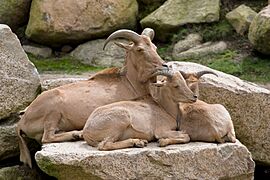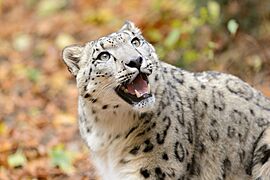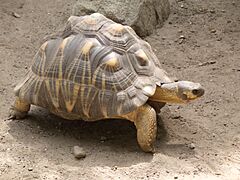Roger Williams Park Zoo facts for kids
 |
|
| Date opened | 1872, June 1, 1980 (renovated/expanded) |
|---|---|
| Location | Providence, Rhode Island, United States |
| Land area | 40 acres |
| Coordinates | 41°47′24″N 71°24′59″W / 41.7899°N 71.4163°W |
| No. of animals | 800 |
| No. of species | 160 |
| Annual visitors | 834,960 |
| Memberships | AZA |
| Major exhibits | Alex and Ani Farmyard, Fabric of Africa, Jambo Junction, Faces of the Rainforest, Feinstein Junior Scholar Wetlands Trail, Marco Polo's Adventure Trek, North America, Our Big Backyard, World of Adaptations |
The Roger Williams Park Zoo in Providence, Rhode Island, is a fantastic place to visit! It's home to over 800 animals from 160 different types of species from all over the world. These animals live in special areas that look like their natural homes.
The zoo first opened way back in 1872, making it one of the oldest zoos in the United States. In 1986, it became the first zoo in New England to get a special approval called "accreditation" from the Association of Zoos and Aquariums. This means it meets very high standards for animal care and education. The zoo is a big part of Roger Williams Park, which also has a fun Carousel Village nearby.
Contents
History of the Zoo
The Roger Williams Park Zoo first opened its doors in 1872. Back then, it had a small collection of animals. These included raccoons, guinea pigs, mice, squirrels, rabbits, hawks, peacocks, and anteaters. The first building for animals, called the Menagerie, opened in 1890.
Growing the Animal Collection
In the 1900s, the zoo started to grow and spread out across the park. It began to feature a wider variety of animals. Visitors could see monkeys, hoofed animals like deer, bears, and even big cats. In 1929, the old Menagerie building was changed into a birdhouse. An elephant barn opened in 1930, which later became the Tropical America building. A new pool for sea lions was built in the 1930s. In 1949, the popular Bunny Village opened, which was a big hit with visitors.
Zoo Improvements and Accreditation
By the mid-1960s, the zoo needed some care and updates. In 1962, a person named Sophie Danforth started the Rhode Island Zoological Society. This group helped people learn about the zoo's needs and raised money for improvements. Today, this society still supports and manages the zoo.
The society opened a gift shop and food stands in 1970. All the money earned went to help the zoo. From 1978 to 1980, the zoo closed for a big upgrade project. During this time, a children's nature center was added. A natural-looking home for polar bears was built, along with a boardwalk through a wetlands area. An exhibit for North American bison also opened.
In the 1980s, new exhibits were built for animals from the South American Pampas and for lemurs. In 1986, the zoo's old stable was turned into an animal hospital, an education center, and offices. Because of these improvements, the zoo became the first in New England to get its special accreditation from the Association of Zoos and Aquariums.
New Exhibits and Future Plans
In 1987, a new plan was made to make the zoo even bigger. Over the years, many new exhibits were built. These included a new sea lion exhibit in 1987 and a Humboldt penguin exhibit in 1988. The Plains of Africa opened between 1991 and 1993, followed by Madagascar in 1995. The Marco Polo Trail opened in 1996.
The old Menagerie building was updated again in 1989, becoming a new gift shop. A brand new animal hospital opened in the spring of 2011. Hasbro's Our Big Backyard opened in 2012 as a fun, interactive play area. A second part of this area, featuring animals native to New England, was finished in 2014. In the summer of 2012, the zoo also opened new homes for takins, red river hogs, and king vultures.
In 2015, the zoo shared a new plan for the next 20 years. This plan included building a new rainforest area, which opened in 2018. It also planned for new exhibits for California sea lions and Humboldt penguins, a bird area for shorebirds, and a new home for tigers. The North America exhibit was also completely redone, featuring grizzly bears, moose, and bighorn sheep.
Animals and Exhibits


The Roger Williams Park Zoo is home to more than 150 rare and amazing animals from all over the world. Here are some of the main exhibits you can explore:
- Alex and Ani Farmyard: This area opened in 2014 and is a petting zoo. You can feed animals here with special food provided by the zoo. It features farm animals like Flemish Giant rabbits, Guinea hogs, Huacaya alpacas, mini Nubian goats, a miniature donkey, Shetland sheep, and different types of chickens. You might also see barn owls, which are often found near farms. There are also fun, interactive stations that show what life on a farm is like.
- Fabric of Africa: This exhibit opened in 1991 and was updated in 2008. It's one of the first exhibits you see when you enter the zoo. It features animals from Africa, such as Aldabra giant tortoises, Ankole-Watusi cattle, bat-eared foxes, black crowned cranes, cheetahs, common ostriches, plains zebras, red river hogs, servals, silvery-cheeked hornbills, and blue wildebeest. This area also includes Jambo Junction.
- Jambo Junction: This part of the Fabric of Africa is home to African bush elephants and Masai giraffes. You can learn how the zoo cares for these huge animals in the Elephant & Giraffe Pavilion, which is an indoor area. The Roger Williams Park Zoo is the only zoo in New England that has African elephants. Their home is very large, covering about 13,500 square feet.
- Faces of the Rainforest: This amazing building opened in 2018. It's designed for animals from tropical rainforests. It has a free-flight area for birds, a beautiful waterfall, and open spaces for monkeys. Animals you might see here include black howler monkeys, Bolivian gray titis, Chilean flamingos, dyeing poison dart frogs, giant anteaters, giant otters, golden lion tamarins, green anacondas, hyacinth macaws, keel-billed toucans, Linnaeus's two-toed sloths, piranhas, scarlet ibises, southern tamanduas, sunbitterns, white-faced sakis, yellow-banded poison dart frogs, and yellow-rumped caciques.
- Feinstein Junior Scholar Wetlands Trail: This is a walking path that shows what natural wetlands in Rhode Island look like. These wetlands are becoming rare as more areas are built up. All the wildlife here is native to Rhode Island. While the zoo protects these animals, they are not owned by the zoo. You might see Canada geese, great blue herons, different kinds of freshwater fish and turtles, and wood ducks. There is also an exhibit for Reeves's muntjacs at the start of the trail.
- Himalayan Trek: This exhibit opened in 1996 as Marco Polo's Adventure Trek, but its name was changed in 2024. It's one of two areas that focus on animals from Asia. It features animals that the famous explorer Marco Polo might have seen on his journeys. These include Bactrian camels, moon bears, red-crowned cranes, red pandas, Sichuan takins, and snow leopards.
- Wild Woodlands: This area was called North America until 2024. It features animals from North America, such as American bison, bald eagles, black vultures, golden eagles, North American porcupines, northern copperhead snakes, pronghorns, red wolves, timber rattlesnakes, turkey vultures and wild turkeys. You can also see harbor seals through an underwater window.
- Our Big Backyard: This is an interactive play space designed for children and families. It encourages outdoor, open-ended play. The play space was funded by the toy company Hasbro and the health company CVS Health. There is also a bird area for common ravens here.
- World of Adaptations: This exhibit used to be called Australasia. It features animals mainly from Southeast Asia and Oceania. You can see Australian snake-necked turtles, Bali mynas, Bennett's wallabies, eastern rosellas, emerald tree boas, Indian blue peafowl, king vultures, Komodo dragons, laughing kookaburras, Matschie's tree kangaroos, North American river otters, North Sulawesi babirusa, northern white-cheeked gibbons, Palawan binturongs, radiated tortoises and wrinkled hornbills. The Komodo dragon at this zoo was the first of its kind in New England.
Gallery
-
Red panda (Ailurus fulgens).
-
Harbor seal (Phoca vitulina).
See also
External links
- Official website: https://www.rwpzoo.org











